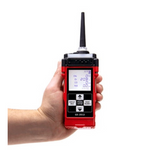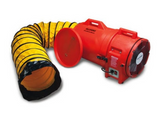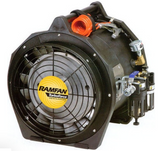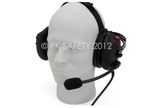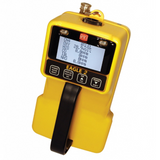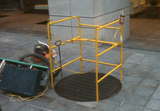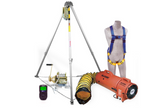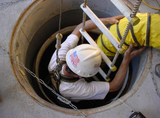Blog
How to Measure Confined Space Gases
Gas measurement is without a doubt the most important part of confined space safety.
Do it right, and you and your crew go home at the end of the day—do it wrong, and you might never go home again! So if you're a newbie (or even a little rusty), you've got to do your homework.
Here's the first lesson: get the right tools! If you already have a gas monitor, take it out and look at it. Without this device you are nothing! It always has to be with you in any confined space — no excuses! But m
…
Dec 5th 2014
Top Ten Things to Consider When Entering a Confined Space
Because of the speed with which a worker can become incapacitated, confined spaces require more safety considerations than typical work sites. Anyone entering a place without adequate ventilation must take precautions for their safety. This is especially true for confined spaces where pooling gases or lack of breathable atmosphere combined with difficult entry and exit can prove fatal.
The Occupational Health and Safety Administration (OSHA) has developed guidelines for safety before an
…
Oct 11th 2014
Confined Space Entry – What to Take When You Go
There are some tools and equipment that anyone performing confined space entry must have to ensure the safety of their workers. Whether your company has determined that confined space procedures need to be developed for your on-site hazards, or if you are a contractor performing a one-time job, equipment such as a gas detector, ventilation fan, harness, tripod and winch will be essential for you or your worker’s safety.
Gas monitors are used to test the atmosphere before entry into the conf
…
Sep 19th 2014
Silent and Deadly, Proper Gas Detection Saves Lives
I’m fascinated about the basics of atmospheric monitoring, how to change the air in a confined space by supplying ventilation, and effective uses of ducting. Aren’t you? Relying solely on your nose (no matter how magnificent it may be) is not the right method to detect airborne hazards. Many gases dull the senses over time, and only a proper gas detection unit with a test probe can properly asses the atmosphere of a confined space.
The shape and location of many confined spaces make them
…
Sep 14th 2014
Wireless QRAE 3 Confined Space Gas Detector from RAE Systems
RAE Systems is the manufacturer of the
QRAE 3, the newest multi-gas monitor for confined space entry. Up to four sensors can be configured in this device for combustible gases (LEL), Oxygen (O2), Carbon Monoxide (CO), Sulfur Dioxide (SO2), Hydrogen Sulfide (H2S), or Hydrogen Cyanide (HCN) depending on the specific needs of your facility.
The interesting thing about this monitor is the wireless configuration option. RAE Systems says this device will work in confined spaces as well. Fo
…
Apr 11th 2014
Confined Space Communication Con-Space Hardline Systems
Communication is essential for many
confined space entry teams. Work environments may be noisy or the entry may take workers further into the space where they can't hear an outside attendant. If safety conditions should deteriorate you can't always count on wireless radios. They have dead zones and are prone to interruption or failure. And when they go down it's usually at an inopportune time.
The Con-Space hardline communication system is simplicity itself. It uses military-grade co
…
Nov 25th 2013
Continuous Gas Monitoring: Using a Gas Monitor in Continuous Operation Mode
Some jobs require continuous gas monitoring of a space over time. Monitors like the
Eagle 2 from RKI Instruments are designed to be used in this way, they are not permanent gas monitors, and should only be used in the continuous operation mode infrequently for short-term monitoring events. With the Eagle 2, the wall switch has a continuous operation switch for this type of operation. When used in this manner, the gas monitor does not need to have the NiMH batteries installed. However, in c
…
May 13th 2013
The GX-2012 Topside Gas Monitor Seen in the Wild!
We just wrote about what a great continuous topside monitor the RKI GX-2012 is. Apparently the word is already on the street. This photo was taken in downtown San Francisco recently. And while all we can guess from this photo is that there may be some vacuuming going on down in that confined space, we are heartened to see they are using not only the reliable RKI Instruments GX-2012, but they are also protecting the area with one of our Allegro Manhole Guard Rails.
Safe confined space entry
…
Apr 24th 2013
Contractor's Confined Space Entry Kit and OSHA Compliance
There are lots of companies out there that do occasional confined space entry work. OSHA requirements for employee safety stay the same whether workers enter these potentially hazardous confined spaces once a year or one thousand times. We've heard from customers over the years that want a kit for confined space entry that won't break the bank or make them invest heavily in equipment. That's why we developed the
Confined Space Entry Contractor's Kit.
This kit has all the required equ
…
Mar 20th 2013
Why 911 Shouldn't Be Your Confined Space Rescue Solution
Confined space entry programs are developed in an attempt to account for any eventuality that may arise from performing work in the potentially life-threatening confined work areas we collectively call "confined spaces". The government work safety oversight body,
OSHA, has extensive requirements for companies conducting this type of work. Yet every year, dozens of workers are killed in these spaces, according to the Bureau of Labor Statistics.
One reason may be an unrealistic expecta
…
Feb 18th 2013



